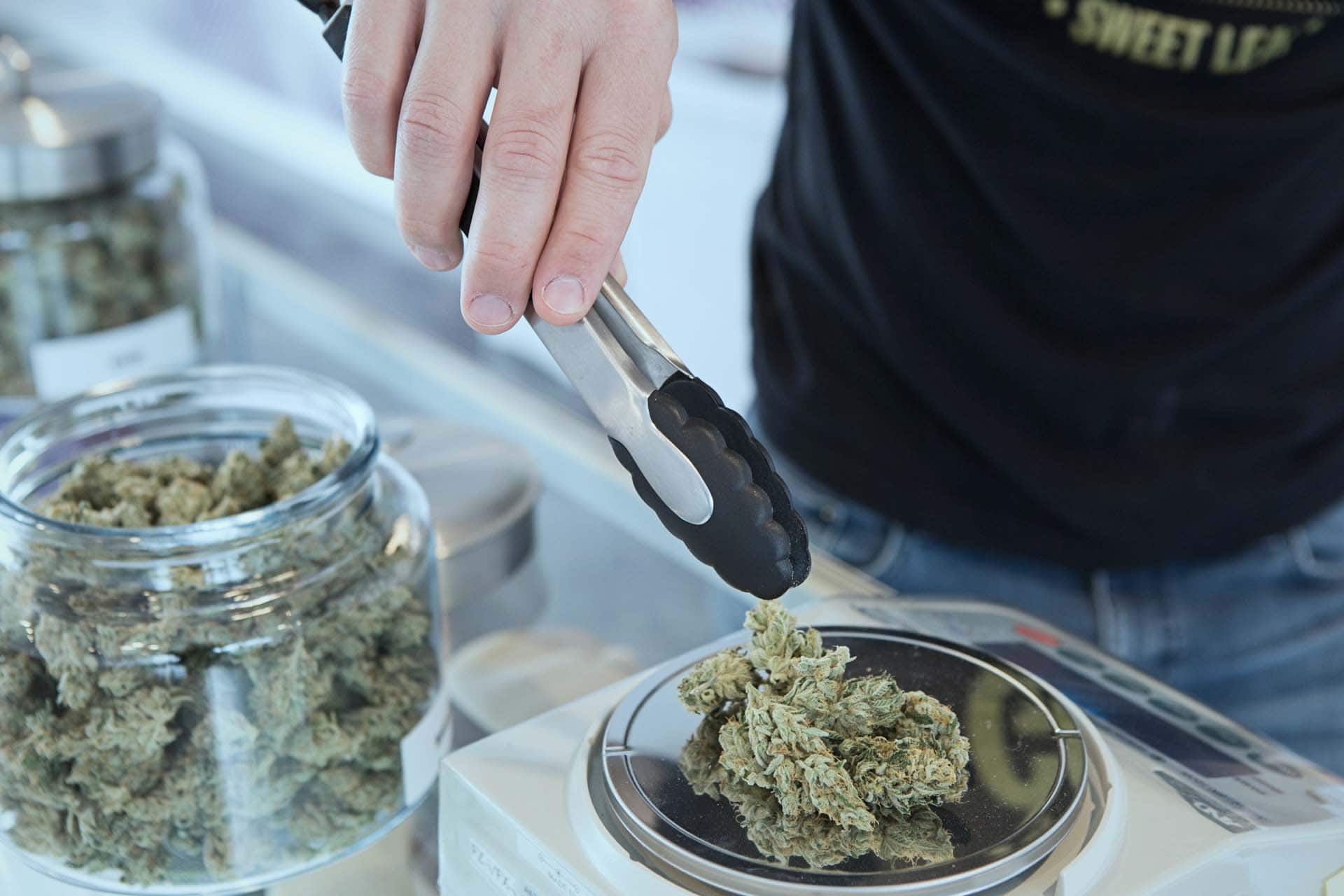Introducing cannabis genetics
Entering a dispensary as a novice to the cannabis world can be a daunting experience. The sight of boards displaying an assortment of unfamiliar names may overwhelm you and without the right information you might not choose the right buds for your use.
The cannabis plant contains two main genetic types; indica and sativa (although there is also a less known 3rd genotype that we’ll discuss later in this article). Each strain has its own properties and effects, suitable for different uses and situations.
With a large variety of marijuana strains available for sale, cannabis dispensaries across Thailand offer customers information about the genetics they are buying to help guide them to making the right choice for their requirements.
Typically they will provide information about the THC or CBD content, the genetic mix of the plant (Sativa, Indica, Hybrid), and tasting/aroma notes.
The terpene shift
In recent years, there has been a shift in how people describe the effects of different strains of cannabis. While the terms “sativa” and “indica” have long been used to categorize weed, there is growing recognition that these labels are not always accurate indicators of a particular strain’s effects.
Instead, many cannabis enthusiasts are turning to terpene profiles to better understand how a particular strain will affect them. Terpenes are the aromatic compounds found in cannabis that give each strain its distinct smell and taste. They are also believed to play a significant role in the effects of the plant.
By focusing on terpene profiles, consumers can gain a more nuanced understanding of a strain’s effects beyond just whether it is sativa or indica.
This shift towards terpene-based descriptions is part of a broader trend towards a more sophisticated and nuanced understanding of cannabis. As more research is conducted on the plant and its effects, consumers are becoming better equipped to make informed decisions about what strains to use and when.
For now though we’ll focus on comparing sativa and indica characteristics, helping you gain a basic understanding of weed genetics before going on to more in depth topics about chemical composition.
Sativa & indica; Here’s all you need to know…
The two main strains of cannabis originate from different places in the world where their different environments caused them to develop in different ways forming variations of the plant. These plants have then been selectively bred to produce the large range of genetics available today.
It is believed that different strains of cannabis have different effects. A sativa-dominant strain, for example, can promote mental energy and heighten your awareness, while an indica strain could give you a physical high and limit anxiety.
Lots of factors influence the effects you experience with cannabis, including your mood and personality. Below is a quick table that shows key differences between the strains:
Origin of Indica and Sativa cannabis strains
Indica strains originated from the Hindu Kush mountain range, which extends from Afghanistan to Pakistan. Sativa strains originated from equatorial regions such as Mexico, Colombia, and Southeast Asia.
Physical characteristics
Different environmental conditions have led to big differences in the plants growing requirements and physical appearance.
Indica strains are short and bushy plants with wide leaves and a short flowering period of around 8 weeks. They produce more yield per square meter than Sativa plants and are more resistant to pests and disease.
Since they are easy to grow faster to bloom and yield a greater amount of buds than sativa plants, indica is popular for those who grow marijuana indoors
Sativa strains are tall (up to 20 feet!), appear more drawn-out in shape with slender narrow leaves and longer flowering periods, ranging from 10 to 16 weeks. Sativa strains are more difficult to grow indoors as they require more space, light, and a longer vegetative period. This strain is typically grown outside in dry and hot climates, such as the South of Africa and Central America.
The origins of sativa and indica strains can significantly impact the flowering time of cannabis plants. Sativa strains originate from equatorial regions, where they evolved to thrive in warm and humid conditions with long days and short nights.
As a result, they typically have a longer flowering time, ranging from 10-14 weeks as there is no cold season for them to finish flowering before. In contrast, indica strains originate from mountainous regions with colder climates and shorter growing seasons. They have adapted to flower quickly and finish their growth cycle within 7-9 weeks.
The difference between sativa and indica can be seen in the appearance and aroma of their buds too. Sativa buds are typically long and thin, with a fluffy texture, and a light green colour, often with a citrus or fruity aroma. In contrast, indica buds are usually shorter and denser, with a darker green colour and a musky, earthy aroma.
The different effects on the user
While it’s commonly believed that indica strains are physically sedating, sativa strains are energizing, and hybrid strains are a combination of both, the reality is more complex. As our knowledge of cannabis grows, we’re learning that indica doesn’t always result in a “couch-lock” effect and sativas don’t necessarily energize all users.
In fact, the terms “indica” and “sativa” are originally botanical terms referring to the physical structure of the plant rather than its effects.
Despite this, the belief that indicas, sativas, and hybrids produce distinct effects is still prevalent in the cannabis community. When visiting a dispensary, it’s not uncommon for a budtender to ask which of the three types you prefer when making a strain recommendation.
These terms are still so widely used and do correctly apply a good portion of the time so we’ll run-through how most on-line shops and bud tenders will associate their products with these strains. Later in the article we’ll look at terpene analysis in more depth and how it is affecting the use of these genetic classifications.
Indica strains are generally known for their calming and relaxing effects, usually making them more suitable for nighttime use or for those who need to relax and unwind after a stressful day. It is said that they can help with sleep disorders, anxiety, and pain relief, mainly due to their higher CBD content. Indica plants are often associated with the ‘body-high’ effect that makes you physically glued to your couch.
Sativa strains, on the other hand, are known for their energizing and uplifting effects, making them suitable for daytime use or for those who need to stay active and focused. Sativa strains can help with depression, fatigue, and nausea although there can be increased anxiety and paranoia in some users. Most people use it for a mental high – to stimulate their minds for creativity or to help power through their day.
The reason for these differences is the chemical makeup of the buds. Indica strains typically have a higher CBD (cannabidiol) content and lower THC (tetrahydrocannabinol) content, while Sativa strains have a higher THC content and lower CBD content. Indica strains typically have a more relaxing and sedative effect, while Sativa strains have a more energizing and uplifting effect.
Hybrids
Hybrid strains are cultivated so that they have a higher yield, grow faster and produce effects suited to what’s desired. Cultivating them requires some knowledge, but there is plenty of room for experimentation to come up with new and exciting genetic mixes. For example, you could theoretically have a bud that will give you a mental high to get things done – while alleviating your pain.
Depending on the ratio of Indica to Sativa they inherit from their parent plants. Hybrid strains can be Indica-dominant, Sativa-dominant, or balanced. These guys are great since they give you the best of both worlds.
With indica-dominant hybrids, the effects of low-THC indica weed will be more prominent. On the other hand, sativa-dominant hybrids may have a high level of THC that is known for its energizing and cerebral effects.
If you like a bit of both, we have just the thing.
AK47 will give you a psychoactive high that is associated with mental and cerebral effects. If you need to get things done, such as work, painting, or anything creative – sativa strains are commonly associated with helping you channel your mind and focus. This is mainly due to these strains have higher concentrations of THC (tetrahydrocannabinol).
A fun fact we stumbled upon is that the popular AK47 strain originally won the Cup in 1999. Four years later, it also captured the title of Indica Cup Champion.
Did you know that all the marijuana buds you’ve smoked in your lifetime are most likely hybrids?
Due to the amount of cross breeding it is thought the last truly pure sativa and indica plants were lost up to 30 years ago!
Cannabis ruderalis
There is a third cannabis strain that is largely overlooked and very rarely mentioned in weed descriptions although there is a big chance you have smoked weed that contains its genetics. As we’ll go on to explain in detail, these genetics allow the possibility to create autoflowers which have grown in popularity over recent years due to the speed in which crops can be grown.
Ruderalis origins
Cannabis ruderalis is a subspecies of the Cannabis plant that is native to regions in Eastern Europe and Central Asia. Unlike its more famous cousins, Cannabis sativa and Cannabis indica, Cannabis ruderalis is a smaller plant with lower levels of THC (tetrahydrocannabinol), the psychoactive compound that produces the “high” associated with cannabis use.
The term “ruderalis” refers to the plant’s ability to grow in harsh environments, such as areas with short growing seasons and low levels of sunlight. This is due to its unique ability to enter the flowering stage of its life cycle based on age, rather than changes in light exposure.
This trait, known as “auto-flowering,” makes Cannabis ruderalis an attractive option for cannabis cultivators looking to produce multiple crops in a single growing season.
Despite its lower levels of THC, Cannabis ruderalis has gained popularity among cannabis breeders due to its unique traits. Its auto-flowering ability can be combined with strains of Cannabis sativa and Cannabis indica to create new hybrid strains that have shorter growing times and higher yields.
Ruderalis uses
Cannabis ruderalis is also being studied for its potential medicinal properties. Although research on the subspecies is still limited, some studies suggest that its high levels of cannabidiol (CBD), a non-psychoactive compound found in cannabis, may be effective in treating a variety of medical conditions, including anxiety, depression, and chronic pain.
In addition to its potential medicinal benefits, Cannabis ruderalis is also being explored for its industrial uses. The plant’s strong fibers can be used to create textiles, paper, and other materials, while its seeds can be used for food and oil production.
However, despite its potential benefits, Cannabis ruderalis is not as widely recognized as its cousins, Cannabis sativa and Cannabis indica. This is largely due to its low levels of THC, which have made it less attractive to recreational users.
In conclusion, Cannabis ruderalis is a lesser-known subspecies of the Cannabis plant with unique auto-flowering traits that make it attractive to cannabis cultivators. Although it has lower levels of THC than other strains, its potential medicinal and industrial uses make it an important area of study for researchers and breeders alike.
Autoflowers
Autoflowering cannabis plants are the result of selective breeding between different cannabis strains, including Ruderalis, Indica, and Sativa.
As we’ve talked about, Ruderalis is a wild cannabis species that originates from Central Asia and Eastern Europe. It is known for its short stature, early maturity, and resistance to harsh climates.
To create autoflower cannabis plants, breeders cross Ruderalis strains with Indica and Sativa to create hybrid plants with the desirable properties of both parent strains. This process involves selecting plants that exhibit desired traits, such as short stature, early maturity, and high potency.
These plants are different from traditional cannabis strains in that they automatically enter the flowering stage after a certain period of time, regardless of light cycle.
Autoflowers offer several benefits over traditional strains, the main advantage being their fast growth and short flowering time. This makes them an ideal choice for cultivators who want to produce multiple harvests per year or who have limited space.
However, there are also some potential drawbacks to autoflowering cannabis plants. One of the main disadvantages is their lower yield potential compared to traditional strains.
This is due to their smaller size and shorter flowering period, which can result in smaller buds. Additionally, some cultivators have reported that auto-flowering strains have a slightly different taste and effect compared to traditional strains.
In terms of growing techniques, autoflowering cannabis plants have different requirements to traditional strains. Because they enter the flowering stage automatically and growth time is limited by this, it is important to provide them with a consistent nutrient and watering schedule to ensure they receive the nutrients they need to produce high-quality buds.
To maximise growth you would also want to increase the amount of time lights are on than for photoperiod plants, increasing photosynthesis and ultimately the growth of plant and buds.
All in all, autoflowers remain a popular choice among cultivators due to their unique properties and ease of cultivation.
Terpenes – Why do they Matter?
Cannabis is a complex plant that contains hundreds of different chemical compounds, including cannabinoids and terpenes. While cannabinoids, such as THC and CBD, have received a lot of attention for their potential therapeutic effects, terpenes are also gaining recognition for their unique properties and potential health benefits.
Terpenes are organic compounds that give cannabis its distinctive aroma and flavour. They are produced in the same glandular trichomes as cannabinoids and can be found in varying levels in different strains of cannabis. There are over 100 different terpenes found in cannabis, each with its own unique characteristics and effects.
Until recently, cannabis strains were primarily classified as either sativa or indica based on their physical characteristics. Sativa strains were believed to provide more energetic and uplifting effects, while indica strains were thought to be more relaxing and sedative.
This classification system has been called into question recently, as there is growing evidence that terpenes play a more significant role in a strain’s effects than its genetic lineage.
Popular terpenes
One of the most popular terpenes found in cannabis is myrcene. This terpene is commonly found in indica strains and is believed to contribute to their relaxing and sedative effects. Myrcene has also been shown to have anti-inflammatory and analgesic properties, making it a potentially useful compound for treating pain and inflammation.
Limonene is another terpene that has gained attention for its potential therapeutic benefits. This terpene is commonly found in sativa strains and is believed to provide uplifting and energizing effects. Limonene has also been shown to have anti-anxiety and anti-depressant properties, making it a potentially useful compound for treating mood disorders.
Other terpenes found in cannabis include beta-caryophyllene, which has anti-inflammatory and analgesic properties, and pinene, which is believed to improve memory and focus.
In addition to their potential therapeutic benefits, terpenes also play an important role in the overall cannabis experience. The unique combination of cannabinoids and terpenes in a particular strain can produce a wide range of effects, from euphoria and creativity to relaxation and sedation.
By focusing on terpene profiles rather than genetic lineage, consumers can better understand and appreciate the complexities of the cannabis plant.
A new way to define cannabis strains effects
The growing interest in terpenes has led to a shift in how cannabis is described and marketed. Many dispensaries and cultivators are now providing detailed information about a strain’s terpene profile, including the specific terpenes present and their levels. This information allows consumers to make more informed decisions about which strains are best suited for their needs.
Overall, the shift towards terpene-based descriptions represents a more sophisticated and nuanced approach to understanding cannabis and its effects. As more research is conducted on the plant and its chemical compounds, we can expect to learn even more about the potential therapeutic benefits of terpenes and how they interact with other compounds in the plant.
In this article, we take some time to explore the attributes of terpenes, how they are produced by plants, and how it affects the cannabis plant.
Conclusion
In conclusion, the three main genetic types of cannabis, Sativa, Indica, and Ruderalis, each have unique characteristics that make them distinct from one another. Understanding the genetic makeup of a particular strain can help consumers make more informed decisions when it comes to selecting cannabis products that align with their desired effects.
It is important to remember that these are botanical classifications and may not be 100% accurate all the time.
Recent developments in the classification of cannabis based on terpene profiles have shown even more promise in accurately identifying and predicting the effects of a particular strain. This new classification system based on terpenes is expected to lead to more accurate labeling and marketing of cannabis products, allowing users to better understand the effects of what they’re consuming.
Overall, the cannabis industry continues to evolve and advance in its understanding of the plant and its effects. As new research emerges, we can expect to see further developments in the classification and understanding of cannabis and its various components, including terpenes, and how they interact with the body.
Hopefully this article has helped grow your knowledge of weed genetics and what to look for when trying to choose buds that are right for you when purchasing weed in Thailand. Look out for information on THC, CBD and strain type to get you started.
As your understanding increases, look further into the strains you like to identify the specific terpenes that suit your tastes and needs. Luckily, weed shops in Thailand are becoming more educated on this and LuckyTree Cannabis offers a wide range of products with detailed information so you can find what suits your needs best.















